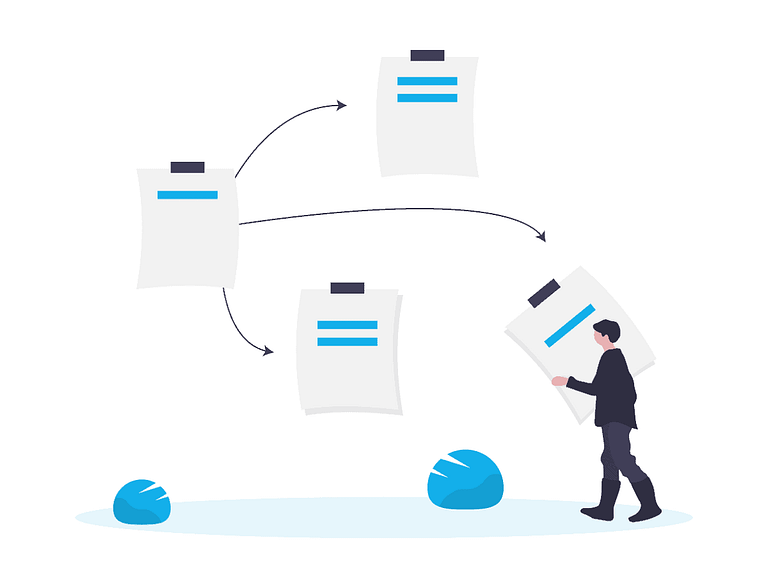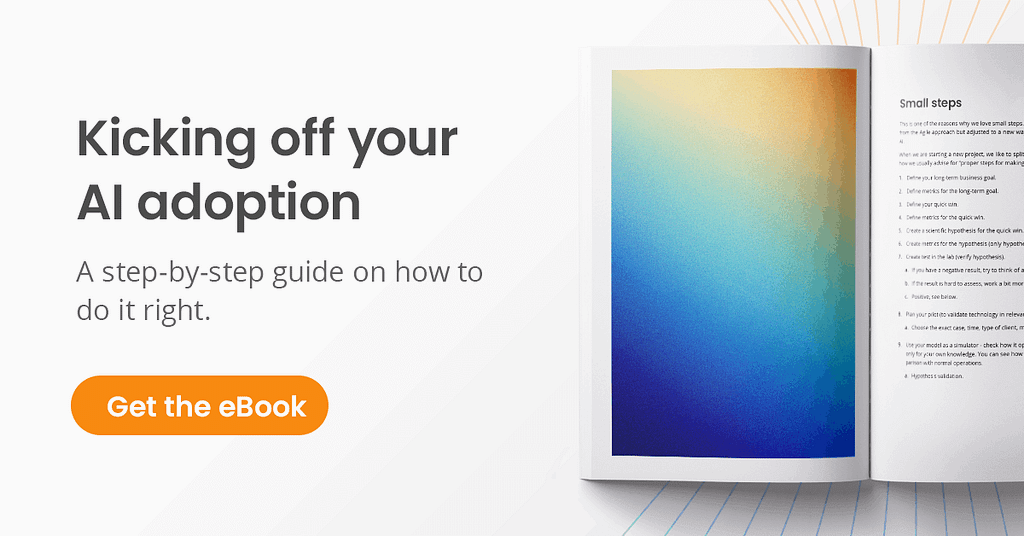5 sales and marketing use cases to maximize ROI
Predictive analytics is a powerful tool enhancing the work of staff across various departments, especially sales and marketing. Predictive analytics unlocks the potential of the data organizations collect – without a way to analyze data and derive insights from it, it’s useless. But with PA, you can make sense of the data you have to make accurate predictions about patterns and behaviors in the future.
In this article, we’ll cover 5 use cases that enhance the operations of sales and marketing teams that help optimize ROI, as well as the basics of predictive analytics.
You’ll learn:
- What is predictive analytics and why is it used?
- The use cases for sales and marketing:
- Lead scoring
- Improved nurturing process
- Maximized CLV
- Reduced churn
- Enhanced content distribution
- What are the best practices to maximize ROI?
What is predictive analytics?
Predictive analytics combines advanced analytics, predictive modeling, data mining, real-time scoring, and machine learning to help companies identify patterns in data. Predictive analytics refers to using historical data to predict what will happen in the future. The historical data is fed into a model that analyzes it to identify patterns. The model learns on the data from the past and is then applied to current data to predict future outcomes. Predictive analytics is already widely used in many ways: customer lifetime value (CLV) measures predict how much a customer will buy from a company, a product recommendation system predicts what the shoppers will like. There are also sales forecasts, credit scores, fraud detection, optimizing marketing campaigns, and predictive maintenance. Some of them seem mundane and don’t make us think of AI, some are more “impressive” – and all are examples of predictive analytics in practice.
Why use predictive analytics?
Predictive analytics can be used for decision-making and solving business problems, as well as identifying new market opportunities, enhancing customer experience, optimizing processes, reducing operational costs, and mitigating risk by predicting problems that may occur.
So why use it?
Imagine a situation in your sales department: think about how the experts make decisions. We call it “based on professional experience” and it’s true, they make decisions with the use of their expert knowledge. But there’s a share of their work which is intuitive – a few simple rules, experience, gut feeling. They know which customer buys what products and what content the audience will be interested in. And while their knowledge comes from their experience, there’s still a large share of guessing or making intuitive choices. But what if you enhance such a team with AI? You use actual data to help them make much more accurate predictions. In some cases, they will be happy to see that what they’ve intuitively known to be true has been confirmed. In other cases, they will be fascinated to see how much potential data unlocks and how much more they can see.
And there’s another benefit here – an expert can leave your company. If you rely on the expertise of one person or a number of well-trained people, you need them to stay, and sometimes it’s just not possible. But the model stays. And the knowledge it unlocked is there to stay, too.
The use cases of predictive analytics are vast and tailor-made to each problem: when you know what question you want the model to answer, a data science team will help you identify the data needed for the training of the model and choose what model has to be built. With the use of predictive analytics, companies are able to analyze and manage pricing trends, making it possible to offer optimal prices at the right time. Businesses are also able to predict the behavior of customers, making it possible to target the right audience and identify users likely to abandon their online experience. What’s more, properly analyzed data gives companies better insight into the groups of their customers and identifying patterns helps create better, more personalized offers.
How to use predictive analytics for sales and marketing?
The fields of sales and marketing can benefit from predictive analytics in a variety of ways. What’s great about the use cases for sales and marketing is that they bring value fast – with the right data and the model in place, the staff can start making data-driven decisions. There’s also a cycle that helps further improve the model and the employees’ operations: when data is used to perform some action, as leads convert to customers, new data comes into play and influences the next generation of marketing activities.
There is a number of ways in which predictive analytics can be used for sales and marketing. Below, you’ll learn more about a selection of 5 common use cases for these areas.
Lead scoring
Lead scoring is not a new idea and it’s been around much longer than predictive analytics. However, like many other activities, especially in sales and marketing, it was quite intuitive and based on one’s professional experience. More of an art than a science, you could say. But today, lead scoring is completely data-driven. Even though it is a known fact that no two leads are created equal, predictive analytics shows the sales team how to use the data about existing customers to predict the likelihood of a lead to convert into a paying customer. Predictive analytics will automatically analyze data (such as demographics and behavioral data) and compare it against the data set of the same information concerning existing customers to figure out whether the lead really has a need for your product or service, at what stage of customer journey the lead is and what their timeline-to-buy looks like, and even which salesperson is most likely to close given deal.
Improved nurturing process
The one-size-fits-all approach is still prevalent in many organizations when it comes to lead nurturing. I’m asking: why? Sales and marketing teams realize that they’re dealing with different individuals, yet somehow they fail to recognize the need for a more personalized nurturing process. In the past, they didn’t know much about the lead, so creating a comprehensive “just-in-case” nurturing was quite a logical choice. However, the best campaigns today move leads towards being sales-ready with customers segmentation and customized nurturing. Demographic and behavioral data gives away a lot and can help companies identify the lead’s level of awareness and the right type of content to help move leads down the funnel.

Maximized CLV
The customer lifetime value is the true measure of marketing ROI.
Again, customers from the past will tell you what future customers will do. Predictive analytics can provide the staff with accurate predictions of CLV. What’s more, PA can be used to maximize the CLV of existing customers with up-sells and cross-sells. Both marketing and sales team now see the value of sustaining the relationships with existing customers instead of focusing solely on acquiring new customers. Having information about customers’ purchase history, a PA model can identify patterns. If John Doe bought items A, B, and C, and James Black bought A and B, will he be interested in C, too? Sales representatives can be notified about cross-sells opportunities (based on customer behavior) to reach out to the customer with a new offer.
And of course, there are the recommender systems. They find similarities between users or items (or both) to suggest content that the customer will be interested in. Systems like that are often used for content-based services, e-commerce, and social media.
Reduced churn
Many companies struggle with growing customer churn – while reducing it is one of the easiest ways to boost revenue. Their customer retention strategies are often based on intuitive actions of sales staff who are randomly contacting customers whose contracts are about to expire. And it’s not effective – when you don’t know who you’re targeting, what arguments can you bring forward to make them stay?
By analyzing behavioral data of customers who have churned in the past, companies can identify customers who are at high risk of churning. Sales staff can be notified about events suggesting potential churn and take action. And to make their activities even better targeted, companies can provide them with personalized offers for such customers. Personalized customer experience has proven to increase customer satisfaction and lead to improved customer loyalty.
Enhanced content distribution
Content marketing can provide significant ROI for the company and that’s why many organizations dedicate a large share of their budget to content creation. But what if you don’t get the results you were expecting? You may not have enough meaningful visits on your website, visitors may quit reading after 15 seconds. There’s a whole variety of things that can happen and that can suggest that your content sucks. But what if I tell you that doesn’t have to be the case?
Content may be distributed in the wrong way. Predictive analytics will answer the question of which content works best for which leads. When you know what types of content resonate with a particular audience and what channels are best to reach the right audience, you can better target the distribution of your content and customize the creation of content. Customized and targeted content is a powerful tool – and used right it can significantly improve conversion rates, bringing new customers.
Read also: Artificial Intelligence in the oil and gas industry
What are the best practices to maximize ROI of predictive analytics?
While companies like Amazon, Netflix or Walmart are making the best of predictive analytics, implementing it in many functions, other companies are sometimes not as happy with the results. That doesn’t mean they don’t see any improvement. They do – they’ve learned how to better target customers at risk of churning, they improved customer engagement, but they’re not using the full potential of predictive analytics – and this also means they’re not maximizing ROI.
Here are some of the crucial things you need to do in order to be able to maximize ROI.
Strategy!
I can’t emphasize that any stronger. This is something mentioned every time we talk about getting ready for AI implementation. No matter what AI technology you want to adopt, you can’t start without a strategy. This includes identifying the appropriate business use case, assessing the current and required data and the skills that you have and you’re missing. Your strategy basically covers all the good practices to make predictive analytics work for your company with the best possible ROI. And it clearly states what you want to achieve and what metrics you want to use to measure progress towards your objective.
Read also: Mistakes of AI adoption: lack of data strategy

Validate your data sets
Is the data that you already have enough? Do you have structured or unstructured data? If you’re missing some information that you need for the model, how are you going to obtain it? You have to consider data collection and storage, among others. Ask questions and look for answers. A predictive model will never work without data, so this part is not just “important” – it is essential to the success of the entire operation.
Prepare your staff
Whether you have an in-house data science team or you’re working with a vendor, data science is not the only department that will work with the model. How come? See, data scientists cover data cleaning, model building, and they set everything up for you. But who gets to work with the outcomes generated by the model? Sales, marketing, another non-tech department. Build a model that will be adjusted to their needs and will generate insights that they will be able to comprehend and make actionable. Teach them how to interpret the results and once they know what question the outcome answers, they will use the insights in their everyday work. Without this understanding, you can create glorified reports, but that’s about all. It’s your staff who know what insights they need, and they have to be taught how to use the model’s outcomes to enhance their work.
Read also: How to start with artificial intelligence: your first steps with AI
Make it last
With predictive analytics, organizations often expect quick wins. And that’s fine, quick wins are generally desirable – they contribute to the long-term goal at the same time validating the concept of PA being of use in your organization. Quick wins bring value in a relatively short period of time, but they’re just the beginning of the road. Don’t lose sight of the end goal – and it’s a long-term one. Make sure that the executives understand the value PA brings and support the commitment to make it work – which includes having the right budget for the data science project and staff training.
Track and measure
Predictive analytics takes the guesswork out of operations and provides staff with measurable, actionable data. You have to make sure that you measure the results using pre-defined metrics and KPIs.
With big data and artificial intelligence tools such as predictive analytics, marketers and sales representatives have powerful analytics tools within their reach. They can find answers to crucial questions. Data-driven insights can be used to support processes at every stage of the funnel to enhance the team’s work and bring better results.


